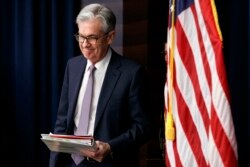The third year of Donald Trump's presidency appears likely to be remembered more for a looming impeachment vote than for anything else. But a look back at 2019 through an economic lens reveals an economy that validates much of the president's Twitter-based boasting, even though some areas leave room for worries about the future.
The main indicators of economic health have continued to move in a positive direction in the U.S. throughout 2019, despite the negative effect of the ongoing trade war with China.
However, a tax cut and a sharp increase in the national debt practically guarantee that interest payments will take up an ever-increasing share of the country's annual budget. At the same time, a downturn in the business cycle could find the Federal Reserve without the tools needed to cushion the impact.
Jobs, jobs, jobs
A promise to create new jobs was a constant feature of Trump's campaign rhetoric in 2016, and since January 2017, the month in which he took office, the country has indeed added jobs — about 6.8 million of them, according to the U.S. Bureau of Labor Statistics.
In 2019 alone, the country added an estimated 1.97 million jobs.
The strong, sustained job growth drove the unemployment rate in November to 3.5%, the lowest point in a generation. The rate of job growth in the U.S. has not actually changed during Trump's presidency. At the beginning of the decade, the country was starting to recover from the "Great Recession." From 2011, the first full year of the economic recovery, through 2016, the economy added an average 2.43 million jobs per year. In Trump's first two years in office, the economy added 2.42 million jobs per year.
Growth
During Trump's first two years in office, overall economic growth increased significantly. Between 2011 and 2016, the U.S. gross domestic product (GDP) increased by an average 2.07% per year. In Trump's first two years, that average increased to 2.9%.
In 2019, however, GDP appeared likely to end the year at a 2.1% rate of growth.
Economists suggest the slowdown is at least partially due to the administration's policies in another of the president's signature interests: foreign trade.
Trade
In 2019, Trump escalated a trade war with China, placing tariffs on hundreds of billions of dollars' worth of imports, which resulted in retaliatory tariffs from China.
As a result, U.S. consumers have paid tens of billions of dollars more for Chinese goods than they would have without the tariffs, and U.S. exporters have suffered a loss of business. Much of the tariff revenue is being channeled into subsidies for U.S. farmers, whose products are being hit hardest by the Chinese tariffs.
Businesses in both countries are feeling the effects of the trade war, with GDP declines evident in both the U.S. and Chinese economies, though the impact in China appears to be more severe. Growth in China hit a 30-year low of 6% in the third quarter of the year. However it is difficult to separate out the relative effects of the trade war from other systemic factors affecting the Chinese economy. As its economy becomes more developed, analysts say it will be all but impossible for China to maintain its track record of double-digit growth rates.
Trump's announcement in early December that he would impose tariffs on steel from Brazil and Argentina, as well as his promise to implement a 100% levy on certain imports from France, suggest that the negative impacts of the trade war with China have not diminished his eagerness to use tariffs as an economic weapon.
Markets
Economists and other experts will rush to warn that "the stock market is not the economy," and they are correct. But the markets do reflect the investing public's confidence in continued economic growth. Throughout Trump's nearly three years in office, market averages have continued on a robust upward slope, hitting new records on a regular basis.
Entering 2019, the markets were coming off a turbulent period, but any doubts about their near-term stability was erased as the year wore on, with major indices showing year-to-date returns of between 20% and 25% through early December.
Bond markets, in which returns are usually an inverse reflection of investor confidence, seem serene about the future, with interest rates relatively low. This means investors don't view lending money to corporations as especially risky at this point in time.
Interest rates
Interest rates have been part of an economic anomaly since before Trump took office. With the economy steadily growing and unemployment declining, the expectation was that wages would rise, driving up consumer demand for goods and services. As a result of increased demand, prices would increase. The typical response to price inflation by the Federal Reserve has always been to increase interest rates. By making it more expensive to borrow money, the Fed could put a damper on consumer spending, keeping inflation in check.
However, as the economy began adding millions of jobs per year in the beginning of the decade, wage growth was slow, if it happened at all, and inflation was consistently below the 2% rate the Fed considers healthy. After keeping interest rates near zero for years, the Fed began a cautious program of increases, bringing interest rates up to 2.5% at the beginning of the year.
However, concern about an economic slowdown — driven in part by the trade war — convinced the board to reverse course, dropping the interest rates to 1.75% in October. This leaves the central bank with little room to maneuver in the case of a severe economic downturn, in which case the primary line of defense would be to cut interest rates.
Deficit
In a period of prolonged economic growth, which should generate an increase in tax revenue, the usual expectation is for the federal government to reduce its deficit. Under the Trump administration, the opposite has occurred.
Despite a growing economy, the federal deficit has increased every year, and in fiscal year 2019, which ended in September, the U.S. added $984 billion to the growing federal debt, which now tops $22 trillion.
The increased debt load of the U.S. is a concern because of the share of the annual budget that is used on interest payments. That share will only grow if revenue numbers fall in an eventual recession, which many economists believe is inevitable in the coming years, given that the economy is in the 11th year of an expansion.














